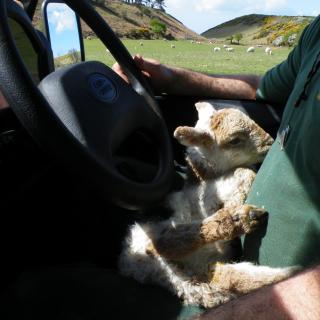Shepherds Are Key To Sustainable Extensive Sheep Farming
Published on 18 December 2009 in Sustainability and Communities

Introduction
The report from SAC’s Rural Policy Centre; ‘Farming’s Retreat from the Hills’ (SAC, 2008) shows that sheep numbers have declined rapidly since 1999 in some areas of Scotland. The decline has accelerated since reform of the Common Agricultural Policy (CAP) in 2005, which saw the introduction of a Single Farm Payment and decoupling of entitlement from livestock numbers. Although the situation is complex and varies with region, it seems likely that these changes to the CAP have made it more difficult to justify keeping sheep and so contributed to the decline in sheep numbers particularly in marginal areas. This decline has important implications for the environment, biodiversity and rural communities.
Now that the financial outputs from sheep farming systems are no longer boosted by headage payments, it is particularly important farmers ensure that costs are minimised if enterprises are to remain viable. Data from the Farm Accounts Scheme for specialist sheep farms in the less favoured areas of Scotland (SAC, 2009) shows that labour costs including the manual labour of farmer and spouse represent about 50% of all costs recorded on such farms. These costs are therefore likely to come under close scrutiny.
However, labour input is an important contributor to productivity. It has also been shown to be important for animal welfare on extensive sheep farms (Stott et al., 2005). Despite this, little is known about labour use on these farms. Research to address this gap would increase understanding of the relationships between labour, productivity, profitability and animal welfare and so contribute towards development of sustainable systems of extensive sheep production.
Key Points
- Sheep numbers are declining substantially in some parts of Scotland.
- Changes in agricultural policy have affected this decline and will alter the way in which farm resources are managed.
- This has implications for farm profits, land use and hence the environment, biodiversity and rural communities.
- Labour management is at the heart of these issues and is also important for animal welfare.
Research Undertaken
Lambing time was selected as a key period for labour management on extensive sheep farms. Through careful observations of shepherding on SAC’s own hill farms, an exhaustive list of labour activities at lambing time was compiled. These activities were then categorised for their likely impact on productivity, profitability and animal welfare. The list was then taken to commercial hill sheep farms and used to aid recording of labour activities at lambing time. A typical breakdown of time looked like this:
.jpg)
From Kirwan, S (2009) Best uses of labour to enhance animal welfare and productivity in extensive sheep farming systems. Report to BPEX, EBLEX, Hybu Cig Cymru, QMS. Postgraduate Students’ Conference. 7-8th December, Kenilworth.
It shows that about 50% of time is taken up by travelling and checking and only very small amounts of time were spent ‘lambing’ or otherwise interacting with individual sheep.
A mathematical programming application was developed to analyse data such as these. This tool established the implications of alternative shepherding strategies. The work demonstrated that shepherds spend a very high proportion of lambing time managing risks to individual animal health and welfare, much more than is necessary to comply with statutory requirements. While this is good for animal welfare it has little impact on productivity or prices and hence depending on alternative uses for the labour is likely to contribute to low farm profits.
Policy Implications
Hill sheep farmers invest a high proportion of their time monitoring the health and welfare of their animals. This investment largely reflects the challenges posed by the extensive nature of these farms, their climate and topography. However, flocks and local breeds are generally well adapted to the conditions and intervention is rarely necessary or desirable. With growing costs of labour and transport and decoupling of CAP support from production, such levels of labour input are generally unprofitable. At the extremes, sheep farming must cease in such regions with implications for the environment and biodiversity or inputs of labour must be reduced with implications for animal welfare.
Further research is needed to establish middle ways that match particular circumstances and allow reduced costs without compromising the public goods that flow from these systems across a high proportion of Scotland’s land area. This research will also provide an evidence base for alternative policies that support such developments in the field.
Author
Dr Alistair Stott, SAC Alistair.Stott@sac.ac.uk
Topics
Sustainability and Communities







